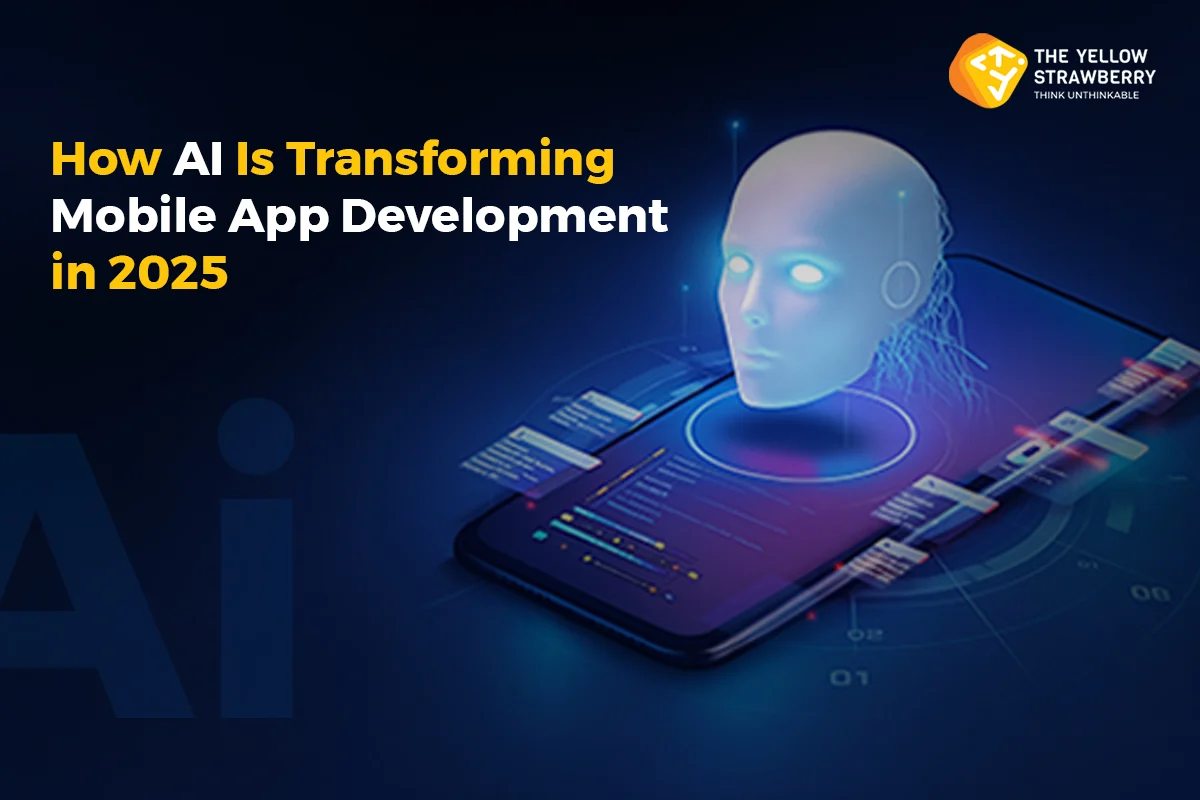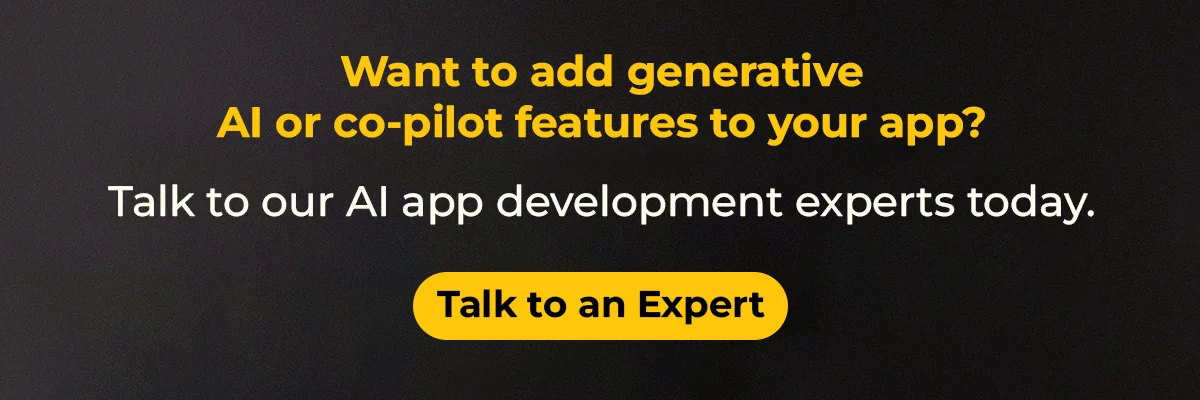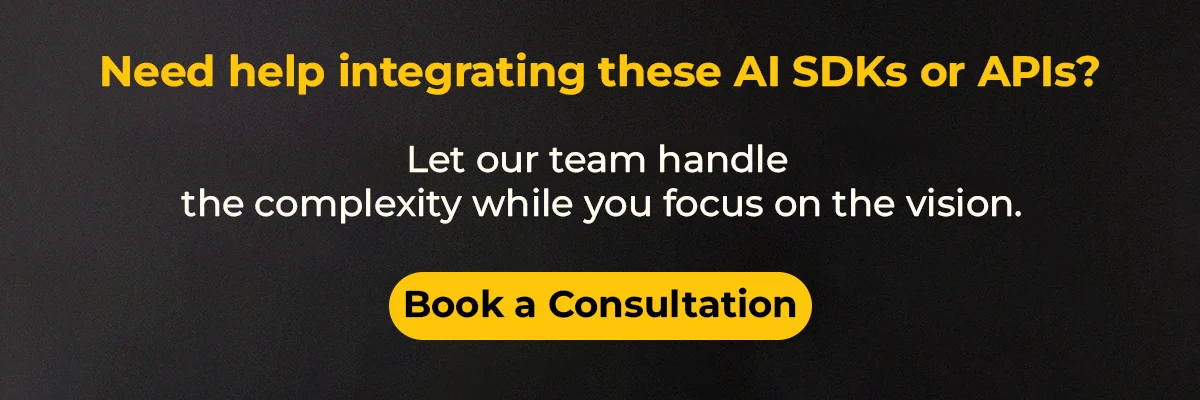
AI mobile app development has moved from novelty to necessity. In 2025 the global AI market is approaching a $400 billion valuation, fueled by breakthroughs in generative models and hardware. Edge computing – which pushes AI from cloud to device – is booming too: IDC estimates global edge computing spend will hit $261 billion in 2025. Against this backdrop, companies are integrating AI as a key differentiator in mobile apps. Leading platforms now offer built-in AI features: Google’s Gemini Nano lets apps run on-device generative AI without internet, while Apple new Foundation Models framework (Apple Intelligence) gives developers free, on-device access to Apple’s powerful AI. These innovations translate into richer, AI-powered mobile experiences with lower latency and stronger privacy exactly what users and regulators expect.
Generative AI & Co-pilots in Mobile Apps
Generative AI features and co-pilots are exploding on mobile. User demand for AI helpers chatbots, image creators, writing assistants, and code-completion tools has driven huge growth. In 2024 Generative AI apps (chatbots, art generators) earned nearly $1.3 billion in global in‑app purchases (up 180% YoY) and saw ~1.5 billion downloads. Tech giants have flooded the market by late 2024, Google Gemini, Microsoft Copilot, and other AI agents were live on mobile. On iOS, Apple Intelligence brings features like AI emoji, Writing Tools (smart proofreading), and Image Playground (on-device image generation) right into apps. Developers can hook into these models using Apple’s new Foundation Models framework tapping the on‑device AI in as little as three lines of Swift code. Apple even makes this AI free to use in apps per Apple’s 2025 announcement, on-device AI inference via Foundation Models comes free of cost with privacy built in.
On Android, Google’s ML Kit Gen AI APIs and AI Edge SDKs let developers integrate generative features too. For example, ML Kit’s Gen AI can do summarization, rewriting, and image captioning using Google models, and Android new Gemini Nano model can run on-device to power chat and creation without cloud calls. In practice, mobile co‑pilots can assist both users and developers. Imagine a note-taking app that uses an AI co-pilot to draft emails or lessons, or a code editor that autocompletes mobile UI code. Start-ups and businesses are building these features to boost engagement & AI-driven personalization and recommendations can significantly increase user retention and usage time (for example, Netflix credits $1 billion in revenue to its AI recommendation engine).
How to use AI in mobile app development
Developers have many tools at their disposal. You can call cloud APIs (OpenAI, Google Cloud AI, etc.) for cutting-edge models, or embed models on-device via SDKs. Mobile-focused frameworks like TensorFlow Lite (cross-platform, low-latency) and Core ML (iOS) make it easy to deploy trained models in-app. Google MediaPipe generative AI tasks also provide ready-to-use on-device language and vision features. In short, integrating AI often means importing an SDK or API, then tailoring a model for your use case (e.g. fine-tuning a GPT-like model on your domain). With today’s SDKs, developers can add intelligent features from chatbots to image filters without reinventing the wheel.
Will AI increase app development costs?
It depends. Integrating AI can add complexity (data pipelines, model training, or third-party API fees), but it can also save money. On-device AI avoids per-call cloud charges, for example- Apple on-device generative model is free to use. Open-source frameworks like TensorFlow Lite, ONNX and built-in tools like Apple Intelligence, Google ML Kit mean there’s no mandatory license fee. In many cases, the improved user engagement and retention from AI features justify any extra development effort. And as hardware becomes more capable, running AI locally can reduce backend costs by eliminating constant server calls, ultimately paying for itself in lower cloud compute bills.
Edge & On-Device AI for Privacy, Speed & Cost-Savings
The shift to edge AI for mobile is one of the biggest trends in 2025. Edge AI means running models on the device (smartphone, IoT device) rather than in the cloud. This yields immediate benefits like lower latency (no network round-trip), offline capability (works without connectivity), lower operating cost (no per-use cloud fees), and improved privacy (sensitive data stays on-device). For example, Apple’s Live Translation in Messages and FaceTime runs entirely on the iPhone, so users’ conversations stay private. Gartner and IDC forecast enormous growth here- IDC estimates global spending on edge computing will grow from $261 billion in 2025 to $380 billion by 2028. As 5G devices proliferate, edge AI hardware is accelerating to meet demand.
The latest smartphone chips are built for AI. Apple A18 Bionic (in iPhone 16 series) features a 16-core Neural Engine optimized for large generative models roughly 6× faster inference than the A13 engine. Its 6‑core CPU is up to 80% faster than older models, enabling smoother AI-driven features. Qualcomm upcoming Snapdragon 8 Gen 4 likewise introduces a new Oryon CPU core and an upgraded Hexagon NPU rumoured to support on-device generative tasks like noise reduction and image enhancement. In practice, this means future Android phones will handle complex AI (even some LLM tasks) with low power consumption. Apple even cites privacy, noting that the iPhone 16 series Apple Intelligence system takes an extraordinary step forward for privacy in AI by running generation locally.
Mobile developers can leverage these hardware gains via SDKs and frameworks. TensorFlow Lite remains the go-to for deploying models on Android and iOS, and Apple’s Core ML (now supplemented by the Foundation Models framework) handles iOS ML tasks. Google provides the AI Edge SDK and ML Kit Gen AI for Android, and new low‑code tools like MediaPipe Tasks let even small teams build edge AI features. The upshot, mobile apps today can run vision, language, and audio models on-device with minimal developer effort. For example, an app might use TensorFlow Lite to do on-device image recognition or speech processing, avoiding any cloud calls. By keeping data local, these apps sidestep privacy issues (since personal data never leaves the user’s device) and meet regulatory requirements more easily.
Benefits for developers and businesses
Integrating on-device AI can transform app experiences. Lower latency means real‑time interactions. an AR game can label objects instantly, a camera app can apply style-transfer filters live, or a keyboard app can suggest replies without lag. User engagement typically jumps when AI features are added (Sensor Tower data shows apps with AI saw rapid growth in downloads and revenue). Meanwhile, businesses benefit from cost savings, reduced cloud spend, and fewer privacy headaches. In fact, on-device AI is a major privacy advantage as one expert notes, processing data locally improves performance and enhances data privacy. Finally, delivering AI features offline is a competitive edge in regions with spotty connectivity. In summary, edge AI means AI-powered mobile experiences that are fast, private, and more cost‑efficient to run.
Governance: AI Regulation & Secure Model Integration
With great power comes great responsibility. As artificial intelligence (AI) becomes ubiquitous in mobile apps, governance and security must take precedence. Regulators worldwide are already taking steps to establish new rules; the European Artificial Intelligence Act was implemented in 2024-25 and places stringent restrictions on high-risk AI systems; multiple U.S. states also recently passed new privacy and AI disclosure laws effective 2025. Mobile apps that employ AI must ensure data protection and transparency for their users, collecting clear user consent for data collection, avoiding biased or disallowed content and keeping records of AI usage. Edge AI approaches make compliance simpler; processing personal information directly reduces exposure to third parties, and using certified SDKs (e.g. Apple Foundation Models or Google AI libraries) allows companies to reduce exposure of personal information to third parties. Relying on frameworks such as Apple Foundation Models or Google AI libraries means choosing frameworks which already incorporate best practices for privacy and security. For instance, Apple emphasizes their design as being privacy-first by not sending data off-device – something Apple Foundation Models don’t do either!
On the security front, developers must carefully integrate AI models. Best practices include using official SDKs or device frameworks to avoid introducing malicious code, keeping models up-to-date, and sandboxing AI inference. Organizations like Cloud Security Alliance advise taking a privacy-first approach when it comes to AI – for example anonymizing training data regularly tested against bias or errors while offering users transparency. Mobile teams should monitor hardware supply chains carefully in order to verify any pre-trained models or NPU firmware is trusted before use.
Finally, API and data governance are of critical importance. When using cloud AI services, developers must safeguard API keys and encrypt any sensitive data during transit. On-device AI may help mitigate some risk but could still leak information if maliciously trained models leak information; security audits and compliance checks should therefore be included as part of every AI mobile project.
Transforming your app with AI can be transformative, but must be executed responsibly. Implementing mobile AI features that comply with user privacy requirements will win user trust while protecting regulatory headaches- in 2025 these qualities become major competitive advantages.
Conclusion: Embrace AI with the Right Partner
AI is reshaping mobile app development. In 2025, success comes from smartly combining generative AI and on-device intelligence. By embedding co-pilots and AI assistants in apps, start-ups and businesses boost engagement and open new revenue streams. By shifting AI to the edge, apps run faster and respect user privacy. And by following the evolving regulations, companies build trust and avoid costly compliance issues.
As a leading mobile app development company, we specialize in all these areas. Our AI-powered solutions help you leverage the newest tools from Apple Intelligence and Gemini Nano integration to TensorFlow Lite and ML Kit implementations. We guide you through data strategy, choose the right AI SDKs for your app, and ensure secure, compliant integration. The result is a mobile experience that delights users with personalization and speed, all while keeping costs and risks low. Ready to transform your app with AI? Our team can help you prototype, build, and scale AI-driven mobile solutions that stand out in 2025 and beyond.








